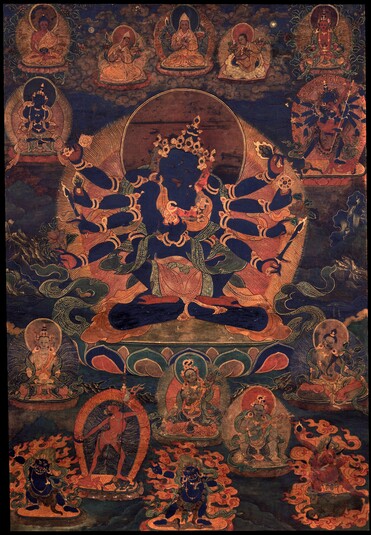
Item: Guhyasamaja (Buddhist Deity) - Akshobhyavajra
| Origin Location | Mongolia |
|---|---|
| Date Range | 1800 - 1899 |
| Lineages | Gelug |
| Material | Ground Mineral Pigment on Cotton |
| Collection | Rubin Museum of Art |
| Catalogue # | acc.# P2001.3.3 |
Guhyasamaja (Secret Assembly) Akshobhyavajra in consort is seated central surrounded by various deities. The deity has three faces and six hands, is blue-black in colour peaceful with a slightly fierce expression seated in vajra posture.
Guhyasamaja has two main traditions, the Arya (Nagarjuna) Lineage and the Jnana (Jnanapada) Lineage. The subject of this painting is the Arya Lineage. Of the three types of Anuttarayoga Tantra this is the chief of the 'Method' (Father) class.
At the top center are three Gelug teachers identifiable by their yellow hats. It is possible that the three teachers are Tsongkapa and the two students Gyaltsab and Kedrubje. The general composition of the three follows the standard model of Tsongkapa however the attributes that the three hold, i.e. the flowers and the objects on top of each blossom are not typically standard to Tsongkapa and his two principal students.
In the left corner is Amitabha Buddha, red in colour, is Nirmanakaya appearance. In the right corner is Amitayus Buddha, identical in entity to Amitabha but not in form, in Sambhogakaya appearance. Slightly below, on the left is Vajradhara, blue, the primordial Buddha. Slightly, below on the right side is the meditational deity Chakrasamvara, blue, with four faces and twelve arms.
At the lower left is Sarvavid Maha Vairochana, white in colour with four faces. On the right is Kasarpani Lokeshvara. Directly in front of the central lotus seat is White Tara with Vajrayogini, red, slightly below to the left and Vina Sarasvati slightly below and to the right, white in colour.
At the bottom left is wrathful Krodha Vajrapani, blue in colour. In the center is Inner Yama Dharmaraja, blue. On the right side is Secret Yama Dharmaraja, red.
Paintings such as this are generally commissioned by a practitioner of Tantric Buddhism for their own use. The figures chosen for the composition are deities special to the practitioner and do not fit into a larger more standardized or orthodox presentation of deities according to a specific tradition.
Numbered List:
1. Guhyasamaja, Akshobhyavajra
2. Gelug Teacher (possibly Tsongkapa)
3. Gelug Teacher
4. Gelug Teacher
5. Amitabha Buddha
6. Amitayus Buddha
7. Vajradhara
8. Chakrasamvara
9. Maha Vairochana, Sarvavid
10. Avalokiteshvara, Khasarpani
11. White Tara
12. Vajrayogini
13. Vina Sarasvati
14. Krodha Vajrapani
15. Yama Dharmaraja, Inner Form
16. Yama Dharmaraja, Secret Form
Jeff Watt 4-98 [updated 8-2011]
Tradition: Gelug Deity Paintings
Collection of Rubin Museum of Art: Painting Gallery 9
Buddhist Deity: Guhyasamaja Main Page
Buddhist Deity: Guhyasamaja, Akshobhyavajra
Collection of Rubin Museum of Art: Mongolia
Iconography: Iconographic Programs
Buddhist Deity: Guhyasamaja, Akshobhyavajra (Personal Painting)


